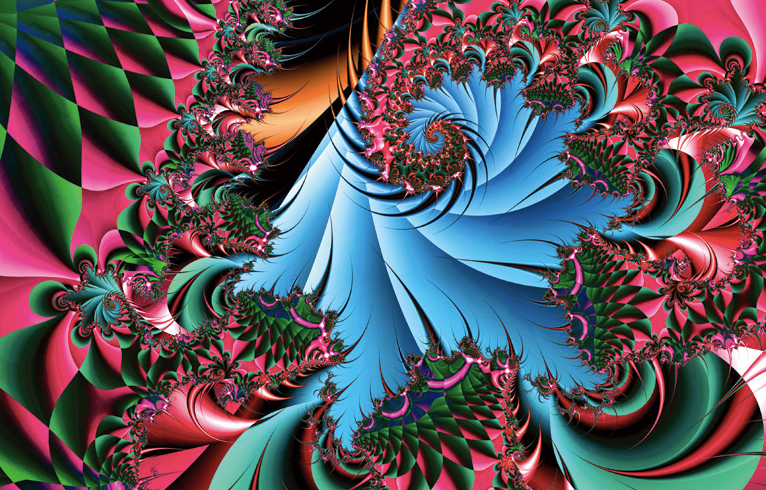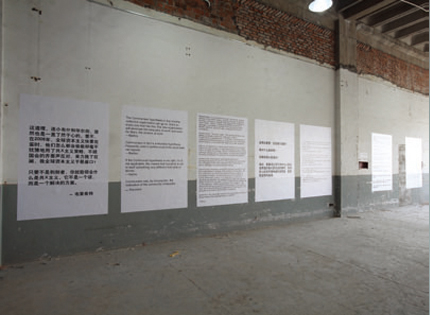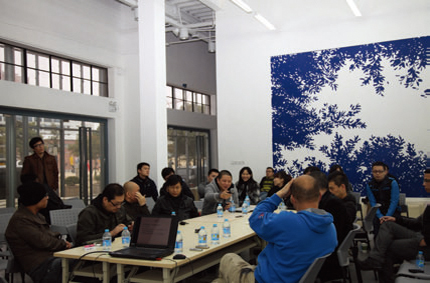FUTURE FESTIVAL: AN ATTEMPT TO INJECT THEORY INTO PRACTICE
| May 14, 2012 | Post In LEAP 14

Apart from housing ShanghART Taopu Warehouse and artist studios, the Taopu art district has also served as the setting for two major exhibitions by local artists: “Future Festival,” and “TOP Contemporary Art Events.” The former was the brainchild of artists Ding Li, Jin Feng, Shi Qing, Yang Zhenzhong, Xu Zhen, and Zhou Xiaohu, among others, and organized seminars with Lu Xinghua, a professor of philosophy at Shanghai’s Tongji University; the latter encompassed the visual arts, theater, and cinema, among a litany of other cultural programs. Structurally, the two exhibitions unfolded in parallel over the course of a year, the “theory” of one almost perfectly juxtaposing the “practice” of the other.
But if the two exhibitions were nothing more than the kind of show where an artist and a theorist join hands to completely bewilder onlookers— who subsequently wander dazedly through the displays like tourists on an academic holiday—then they would not have produced the kind of interest they have. On the contrary, a year’s worth of events at Taopu have seen the two exhibitions become something of a phenomenon. The role that the left-wing scholar Lu Xinghua has played in the process cannot be overlooked.
The story of how Lu Xinghua fell into Chinese contemporary art’s field of vision is somewhat dramatic. It can all be traced back to a blowup on Weibo in the fall of last year, initially started by Lu’s criticism of Internet “yuppies”: he claimed that, in supporting certain other “individuals of conscience” (and their suspect willingness to feel the masses’ pain), they too were making a show of their concern for the plight of others. Due to Lu’s volatile style of writing, things began to get heated. People in the art scene are a connected bunch: a great number of artists, critics, curators, and art lovers found themselves dragged in, either directly or indirectly. Like a snowball rolling down a hill, this war of words eventually took on extra-large proportions, and “Theoretical Workshop’s Backdoor” (Lu’s Weibo handle) had found himself tagged with the label of “the mad dog of Weibo.”

By this point, however, the seminars held by Lu Xinghua and the artists of Taopu had already been going on for half a year. They had been meeting every Wednesday to talk about the links between art and Lu’s research on contemporary French philosophy. After each of their discussions, the minutes were posted on the “Future Festival” blog; separately, a series of documentaries on the seminars shot by Yang Zhenzhong was screened at ShanghART Warehouse. From an audience of 50 at the Feburary 2011 opening of “Future Festival” at Minsheng Art Museum, the number of people attending the discussions quickly winnowed to a steady group of ten who showed up each week at the TOP Contemporary Art Center inside the Taopu complex. Some artists attended only once, then never came back, claiming that the philosophical theories being discussed had nothing to do with their work. Others parted from their discussions with Lu on bad terms. Artists are admittedly a species with an innate disgust for anything “collective,” and academic texts do not “benefit” their work. So in the wake of the online upheaval, the talks at Taopu gradually became an island unto themselves.
As one of the main actors in the drama, Lu Xinghua could hardly be more indifferent. Bring up the idea that he brought all this reproach on himself, and he replies straightforwardly: “I never asked for anyone to support me. In the end I can only rely on myself.” Of course, relying on himself means, apart from his work in academia, that Lu also has projects on the side. He opened a small clothing store in a city nearby Shanghai that trades in imported clothing. The store is small, but business is good— or at least good enough that he doesn’t have to worry about supporting himself with his theoretical work.
Lu Xinghua’s research on leftist theory, including work on Jacques Rancière, Alain Badiou, Giorgio Agamben, and Slavoj Žižek, doesn’t fall within the scope of this essay; what interests LEAP is how he has used their theories to get a rise out of art circles, inciting discussions on things like the relationship between art and society, or art and politics.
Since 2000, government control has gradually loosened, the art market has begun to flourish, media scrutiny has increased accordingly, and Chinese artists have slowly gained recognition in the West. But, as in any breeding ground, pathogens have proliferated. Moneyed interests have come to the fore, bringing with them countless power struggles, and whispered conspiracies over turf wars. Suddenly everyone wants to leave their mark on the nascent field of Chinese contemporary art. A few explosive essays posted recently on Weibo and Douban by people with mysterious usernames are excellent examples of this. But with all the commotion, and all the profit, eventually it is art itself that gets left out in the cold, to the general lament of all concerned.
Looking back, it is not unfair to say that the straightened material circumstances of the 1980s and 90s resulted in an intellectual milieu without parallel. But the struggles of the past, carried down to the present day, have plainly passed their expiration dates. The reality of China today is more complicated, and as contemporary art gains ground, so the original sin of its artists seems that much more profound.
In 2009, nine Shanghai artists— several of whom would go on to organize the exhibitions at Taopu— staged an exhibition at Shanghai Songjiang Creative Studio titled “Bourgeoisified Proletariat.” Their intention in selecting such a theme— coming as it did precisely 60 years after the founding of a new China— could not have been more obvious. In confronting the political and social problems of a capitalist economy, this group of middle-aged artists hoped to break the current logjam, and find a new way forward.

Of course, in seeking recent examples of art’s involvement in society, the case that springs most readily to mind is also the most extreme— Ai Weiwei. Lu Xinghua has posted essays online criticizing Ai. As Lu would have it, Ai’s politics “lack a certain grandeur,” his advocacy of political positions do little to advance art generally, and the excessive attention paid him by the foreign media obscures the reality of life in the lower strata of Chinese society. As his fans increased in number, the idol-smashing Ai of old slowly became an idol himself, or as Boris Groys would put it in Self-Design and Aesthetic Responsibility, “the artist ceases to be an image producer and becomes an image himself.” In that moment, the artist surrenders a part of him or herself. Where politics are concerned, there is never any guarantee that, in the light of one-sided public opinion, “benevolence will be repaid with benevolence”; it is even more so where art is concerned.
At the same time, Lu Xinghua does not endorse blindly focusing on creating artworks. He explains: “The important part isn’t the little stories told in works. That is not to say that there is nothing important about an individual work, but rather that it doesn’t matter whether what it says has anything to with art before the artwork it is shown in the exhibition space.” Lu opposes “narcissism” on the part of artists, saying “no matter how well an image is manufactured, it is still just a ready-made object.” It is widely agreed that the loss of religious and royal backing forced Western art to submit to the scrutiny of the public. In China, there is another thread to the narrative: ancient painters were particular about the quality of the painting, believing that the quality of the painting reflected the quality of the man. But Lu thinks that even this should be repudiated. Or in other words, an artist’s self-cultivation cannot guarantee the quality of his or her work. Time and time again, Lu has emphasized that “exhibition is greater than creation,” an advocacy which, at its root, is the same as saying “neither good writers or bad writers can compare to the writer who is not there.” This point fits snugly with Lu’s consistent opposition to intellectuals’ social authority, and has proven difficult for more than a few artists to accept.
In September of last year, Yang Zhenzhong, Zhou Xiaohu, Xu Zhen, Jin Feng, Lu Xinghua, Ding Li, Shi Qing, and Philippe Pirotte staged “Poster Exhibition” at TOP Contemporary Art Center, inviting almost 60 artists from both inside and outside China to produce posters on the theme of “My Communism.” According to Jin Feng they sent out more than 60 invitations, but some artists turned them down flatly, professing no interest in the theme. Many of those who did end up participating used the poster medium to express their anger in no uncertain terms. Jin admitted that it might seem a little like they were taking a collective position, but that this exhibition had allowed them to uncover a number of interesting problems— for example, the relative evasiveness of the space’s previous two events. Because the medium had been set in advance, artists were not able to fall back on their preferred modes of expression, while the exhibition evinced a historical consciousness that was bound to make Chinese artists— especially middle-aged ones— apprehensive: in confronting the sensitive vocabulary of the twentieth century, what is there left to say? Seen from this point of view, there were indeed places where “Poster Exhibition” coincided with Lu Xinghua’s “theory.” But Lu himself claims that he hadn’t taken the exhibition very seriously. “A rigorous exhibition needs to be rigorously curated. You can’t let just anyone in,” he says. “But at this point I can tolerate that method; it’s better than if the artists were to do exactly as they are told.”

Many in the art world have been baffled by the persistence of the cooperation between Lu Xinghua and the artists of Taopu. In its one year of existence, “Future Festival” has encountered difficulties of all stripes— the majority coming in the form of exhortations from well-meaning friends. On the one hand, they came bearing “expert opinions” from the world of philosophy, informing the participants of the academic inadequacy of Lu’s work. On the other, they urged the Taopu artists not to go blindly chasing after the theory du jour. But, gradually, the passage of time wrought a subtle change in the hearts and minds of participants and onlookers alike. The more people examined the “Taopu phenomenon,” the less they understood it, and the less they were willing to criticize it hastily. That events would take such an odd turn might be due to the ambiguous relationship that has always existed in China between theory and practice, between critics and artists. Twenty years ago, the majority of Chinese artists— operating in a closed-off, hostile domestic environment— had no way to make their voices heard. Consequently, critics or curators who had a head start in Western art history and theory took on the role of spokespersons, placing Chinese artists into an academic framework that allowed them to be understood and interpreted by the West, and which allowed their work to gain acceptance overseas. Transport the same model to the present-day, however, and it loses all effectiveness. Nowadays, not only is it impossible for any one individual or group to monopolize “academic resources” in such a way, but any artists looking to use the latest theory to cast their works in a flattering light will be quickly called out. But the shadow of history is not so easily cast aside. Owing to China’s particular circumstances, any cooperation between art and theory is bound to be looked upon as both dubious and awkward.
As such, whatever exhibition next opens at TOP Contemporary Art Center is doomed to be viewed with suspicion by the public. At the moment, TOP is structurally not unlike a small political party. Not only does it have its own territory and agenda, but it has media resources at its disposal, among them a Weibo account, patronage from Art-Ba-Ba, and a series of monthly publications. The most notable difference is that it has yet to develop slogans and guiding principles of its own. Although last year’s “Poster Exhibition” tapped Communism for its theme, the treatment of it was open-ended and unprejudiced. Lu Xinghua might not agree with this point, but it does prove that the linkages between art and theory may not be as simple as they once were; it is precisely because someone like Lu— who brandishes such an intrepid pen— so easily inspires slogans and stances in others, that the artists of Taopu have avoided doing just that.
As for the cohesion and originality of Lu Xinghua’s theories, this is something for which Lu himself must take responsibility. He opposes the use of any fixed historical narrative to cull and rank images, a radical stance that can sometimes lead one to suspect that Lu is wielding his one ideology to combat all the others. But for contemporary Chinese art criticism— which is even more torpid than the art it proposes to critique— Lu’s appearance is undoubtedly significant. His stubborn, tenacious approach reminds those who would oppose him that they cannot be content with “pure” stances; that the only way to oppose or to overturn his narrative is the balanced use of diverse sources and methods. When asked what he would do if all his closely held beliefs turned out to be wrong, Lu’s reply was full-throated: “If my point of view is wrong, and needs to be cast aside, then I’ll still be the happiest, proudest guy around. I’ll think, ‘I can cast it aside; looks like I’m finally starting to make progress.’”


